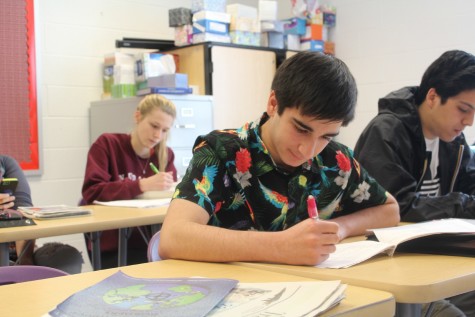Nan Denette – Wooster College
I read the first page of David Foster Wallace’s 1079 page novel Infinite Jest in November of my sophomore year. I was stopped when my dad, standing in the doorway, laughed and said dryly “You’ve got to be kidding me.” I wasn’t. “It’s fascinating so far,” I explained, wishing I had some dark-framed reading glasses to take off in annoyance as I closed the book and looked up at him. “I’m in English Honors, you know.” Dad shook his head, and returned a minute later with a smaller paperback. “These are some of Wallace’s essays. Why don’t you start with something more manageable.” I sighed, picking up the book and thumbing through it. 213 pages. I looked at the larger book in my lap (that, in hindsight, made me look like a toddler stomping around in her parent’s oversized shoes) and decided, grudgingly, to take Dad’s advice.
One novel, eight short stories, and many essays later, I was thoroughly convinced that Mr. Wallace was the only person who understood humanity’s great and terrible flaws. I plucked words out of everything from Big Red Son to Broom of the System, taking phrases like “banal platitude”, “transcendence of sentiment” or “capital-T Truth” and forcing them anywhere I could. This, unfortunately, earned me quite a few red-penned question marks on essays the following months. But I didn’t care. I was finally ready to start page 2.
I decided the extra three pounds I carried in my backpack were definitely worth being able to pull this literary leviathan out at lunch just so people would see me reading it. I soon realized, however, that Infinite Jest wasn’t the type of book that you could jump in and out of any time. It demanded a comfortable armchair or a table at a coffee shop, and much more than five or ten minutes at a time. Because of this, my bookmark didn’t pass page 91. I would try again every few weeks, but no matter how hard I pushed I couldn’t make my way through the two-inch brick of paper and into the world of the Enfield Tennis Academy and Hal and those two detectives, whatever their names were, and the meth addict from chapter two, and- god, why couldn’t I remember any more of the characters? They had all felt so life-changingly important when I was reading about them, but now they were just strange, misshapen fragments of something I could no longer piece together. What was the Jest? What was so Infinite about it? What was the man taking meth for 59 straight pages going to teach me about the human condition? Eventually, I resigned myself to not knowing. As it sat on my desk collecting dust, Infinite Jest turned into a symbol for failure, and I kicked myself for failing to get through even a tenth of it.
There was absolutely nothing I wanted more than to read the final sentence of the novel, sit back in my chair, and feel the harsh realizations, the tragic heartbreak, the imminent gravity of everything Mr. Wallace had poured into this elaborate universe of a book. Surely, I told myself, absorbing this sheer magnitude of aureate prose would saturate me with literary brilliance through some kind of ink-and-paper osmosis. (The meth-addict character had become strangely relatable.) I wasn’t enjoying any parts, just grasping at the whole and failing miserably. I had been reading Infinite Jest in a desperate attempt at enlightenment. And that’s not what reading should be. It’s supposed to be exciting, fun, challenging, and every other type of rewarding there is. As long as the experience is about the novel itself, and not the grandiose idea of it.
I still haven’t finished Infinite Jest. I have 821 pages left, but I’m in no hurry. I am not setting out to finish 821 more pages of heavy prose; I’m setting out to finish a novel.
Nan Denette is freshman at the College of Wooster and this essay was submitted as her Common App essay.



